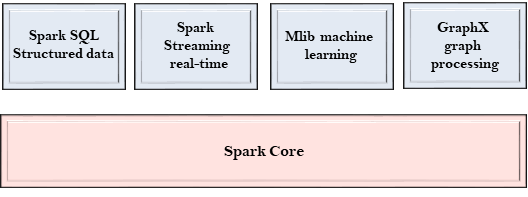Spark Components
The Spark project consists of different types of tightly integrated components. At its core, Spark is a computational engine that can schedule, distribute and monitor multiple applications.
Let's understand each Spark component in detail.

Spark Core
- The Spark Core is the heart of Spark and performs the core functionality.
- It holds the components for task scheduling, fault recovery, interacting with storage systems and memory management.
Spark SQL
- The Spark SQL is built on the top of Spark Core. It provides support for structured data.
- It allows to query the data via SQL (Structured Query Language) as well as the Apache Hive variant of SQL?called the HQL (Hive Query Language).
- It supports JDBC and ODBC connections that establish a relation between Java objects and existing databases, data warehouses and business intelligence tools.
- It also supports various sources of data like Hive tables, Parquet, and JSON.
Spark Streaming
- Spark Streaming is a Spark component that supports scalable and fault-tolerant processing of streaming data.
- It uses Spark Core's fast scheduling capability to perform streaming analytics.
- It accepts data in mini-batches and performs RDD transformations on that data.
- Its design ensures that the applications written for streaming data can be reused to analyze batches of historical data with little modification.
- The log files generated by web servers can be considered as a real-time example of a data stream.
MLlib
- The MLlib is a Machine Learning library that contains various machine learning algorithms.
- These include correlations and hypothesis testing, classification and regression, clustering, and principal component analysis.
- It is nine times faster than the disk-based implementation used by Apache Mahout.
GraphX
- The GraphX is a library that is used to manipulate graphs and perform graph-parallel computations.
- It facilitates to create a directed graph with arbitrary properties attached to each vertex and edge.
- To manipulate graph, it supports various fundamental operators like subgraph, join Vertices, and aggregate Messages.
|

 For Videos Join Our Youtube Channel: Join Now
For Videos Join Our Youtube Channel: Join Now










